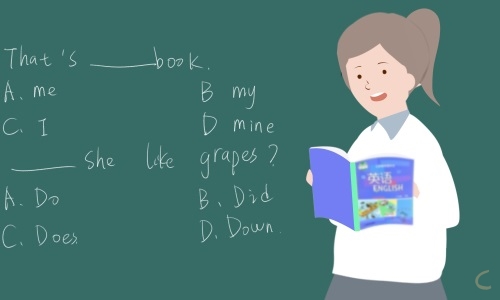初三英语语法知识点
初三英语语法知识点梳理
高效的学习,我们要学会给自己定定目标(大、小、长、短),这样学习会有一个方向;然后要学会梳理自身学习情况,以课本为基础,结合自己做的笔记、试卷、掌握的薄弱环节、存在的问题等,下面小编为大家带来初三英语语法知识点,希望对您有所帮助!

初三英语语法知识点
可数名词变复数的几种形式
1.单数名词加s: students, apples, bags, trees, books, brothers.
2.以s、x、sh、ch结尾的名词加es: glasses, boxes, brushes, matches.
3.以辅音字母加y结尾的名词,变y为i加es: cities, babies, enemies.
4.以f或fe结尾的名词,多数变f为v加es: wives, knives.但有些词只加s: roofs,proofs, chiefs.
5.以o结尾的名词,有些加es: Negroes, heroes, tomatoes, potatoes. 其它加s: radio s, zoos, pianos, photos.
6.不规则名词:foot→feet, goose→geese, tooth→teeth, child→children, man→men, woman→women, mouse→mice.
7.单复数同形的名词:sheep,fish,dee.
初三英语语法重要知识点
主动语态和被动语态
主动语态(The Active Voice)表示主语是动作的执行者。
被动语态(The Passive Voice)表示主语是动作的承受者。
构成:承受者+助动词be+及物动词的过去分词+by+执行者
一般现在时:承受者+助动词am / is/are +及物动词的过去分词+by+执行者
一般过去时:承受者+助动词was / were +及物动词的过去分词+by+执行者
承受者+助动词shall / will be+及物动词的过去分词+by+执行者
承受者+助动词 have/ has been+及物动词的过去分词+by+执行者
承受者+ can /may/must/should +be+及物动词的过去分词+by+执行者
从句
1.宾语从句
在复合句中,由一个句子充当宾语,这个句子叫做宾语从句。宾语从句主要有三种类型,分别是that引导的宾语从句、if或whether引导的宾从、连接代词和连接副词引导的宾语从句。 常见的宾语从句引导词:that、if、whether、what、who、where、why和how。
Eg. I am sad that you refused me. 我很难过你拒绝了我。
2.定语从句
定语从句在中考和高考中出现的频率都非常高。在复合句中,修饰名词或代词的从句叫定语从句。被修饰的名词或代词叫先行词。定语从句一般放在先行词的后面。常见的关系代词包括that,which,who(宾格whom,所有格whose),as 等,关系副词包括where,when,why等。
Eg. Lily likes music that is quiet and gentle. 玛丽喜欢轻柔的音乐。
3.状语从句
状语从句就是由一个句子在复合句中充当状语。所以状语从句又可以分为时间状语从句、地点状语从句、原因状语从句、目的状语从句、结果状语从句等等。每种状语从句都有特定的引导词:
(1)地点状语从句:where,wherever
(2)时间状语从句:when, while, as, before, until, till, since
(3)原因状语从句:because, since,as, now that, not that…, but that…, seeing that,
considering that, in that
(4)目的状语从句:so, so that, in order that, that, to the end that, in case,for fear that,lest
(5)结果状语从句:so...that, such that, so that, with the result that
(6)条件状语从句:if,unless,if only,only if,in case,suppose/supposing
(that),provided/providing(that),on condition that,so/as long as
(7)方式状语从句:as, as if, as though
(8)让步状语从句:though, although, as, even if, even though, whether, no matter
whether...or, no matter with
初三英语语法复习知识点
固定搭配:
only a few (=few)not a few (=many)quite a few (=many)
many a (=many)
Many books were sold.
Many a book was sold.
卖出了许多书.
9many, much的用法
Many,much都意为"许多",many +可数名词,much +不可数名词.
How many people are there at the meeting
How much time has we left
Many of the workers were at the meeting.
Much of the time was spent on learning.
初三英语语法知识点归纳
介词的固定搭配
介词往往同其他词类形成了固定搭配关系。记住这种固定搭配关系,才能正确使用介词。
(1)介词与动词的搭配
listen to , laugh at, get to, look for wait for, hear from, turn on, turn off, worry about, think of, look after, spend…on…, 等。
(2)介词与名词的搭配
on time, in time, by bus, on foot, with pleasure, on one’s way to, in trouble, at breakfast, at the end of, in the end等。
(3)介词与形容词的搭配
be late for, be afraid of, be good at, be interested in, be angry with, be full of, be sorry for等。
短语动词的分类
(1)动词+介词
常见的有look for, look after, ask for, laugh at, hear of 等。这类短语动词的`宾语只能放在介词后。如:
Don’t laugh at others.
Tom asked his parents for a bike.
(2)动词+副词
常见的有give up, pick up, think over, find out, hand in,等。这类短语动词的宾语如果是名词,既可放在副词前边,又可放在副词后边;宾语如果是人称代词或反身代词,则要放在副词前边。如:
You’ll hand in your homework tomorrow.
Please don’t forget to hand it in.
(3)动词+副词+介词
常见的有 go on with, catch up with等。这类短语动词的宾语只能放在介词后边。如:
Go on and I’ll catch up with you in five minutes.
After a short rest, he went on with his research work.
(4)动词+名词+介词
常见的有take care of, make use of, pay attention to, make fun of 等。这类短语动词的宾语只能放在介词后边。如:
You should pay attention to your handwriting.
We should make full use of our time.
(5)动词+形容词
常见的有leave open, set free, cut open等。这类短语动词的宾语如果是名词,则宾语可放在形容词的前边,也可放在后边;宾语如果是人称代词或反身代词,则必须放在形容词前边。如:
The prisoners were set free.
He cut it open.
(6)动词+名词
常见的有take place, make friends等。这类短语动词用作不及物动词。如:
This story took place three years ago.
I make friends with a lot of people.
初三英语语法知识点总结
1.介词的功能
介词是一种虚词,用来表示名词或相当于名词的其它词语句中其它词的关系,不能单独使用。介词可与名词或相当于名词的其它词构成介词短语。介词短语可在句中作定语,状语,表语和宾语补足语。例如:
The boy over there is John’s brother. (定语)
The girl will be back in two hours. (状语)
Our English teacher is from Australia. (表语)
Help yourself to some fish. (宾语补足语)
2.常用介词的用法辨析
(1)表时间的介词
at, in on
表示时间点用at。例如:at six o’clock, at noon, at midnight。表示在某个世纪,某年,某月,某个季节以及早晨,上午,下午,晚上时,用in。例如:in the ninettenth century, in 2002, in may, in winter, in the morning, in the afternoon等。表示具体的某一天和某一天的上午,下午,晚上时,用on。例如:on Monday, on July 1st, on Sunday morning等。
since, after
由since和after 引导的词组都可表示从过去某一点开始的时段,但since词组表示的时段一直延续到说话的时刻,因而往往要与现在完成时连用。而after词组所表示的时段纯系过去,因而要与一般过去时连用。例如:
I haven’t heard from him since last summer.
After five days the boy came back.
in, after
in与将来时态连用时,表示“过多长时间以后”的意思,后面跟表示一段时间的词语。After与将来时态连用时,后面只能跟表示时间点的词语。After与过去时态连用时,后面才能跟表示一段时间的词语。例如:
He will be back in two months.
He will arrive after four o’clock.
He returned after a month.
(2)表示地点的介词
at, in, on
at一般指小地方;in一般指大地方或某个范围之内;on往往表示“在某个物体的表面”。例如:
He arrived in Shanghai yesterday.
They arrived at a small village before dark.
There is a big hole in the wall.
The teacher put up a picture on the wall.
over, above, on
over, on和above都可表示“在……上面”,但具体含义不同。Over表示位置高于某物,在某物的正上方,其反义词是under。 above也表示位置高于某物,但不一定在正上方,其反义词是below。On指两个物体表面接触,一个在另一的上面。例如:
There is a bridge over the river.
We flew above the clouds.
They put some flowers on the teacher’s desk.
across, through
across和through均可表示“从这一边到另一边”,但用法不同。Across的含义与on有关,表示动作在某一物体的表面进行。Throgh的含义与in有关,表示动作是在三维空间进行。例如:
The dog ran across the grass.
The boy swam across the river.
They walked through the forest.
I pushed through the crowds.
in front of, in the front of
in front of 表示“在某人或某物的前面”,在某个范围以外;in the front of 表示“在……的前部”,在某个范围以内。例如:
There are some tall trees in front of the building.
The teacher is sitting in the front of the classroom.
